

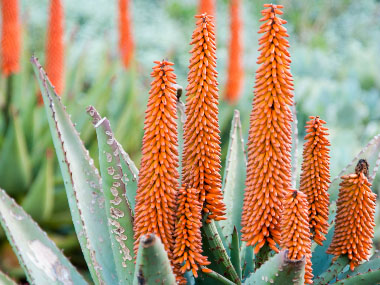
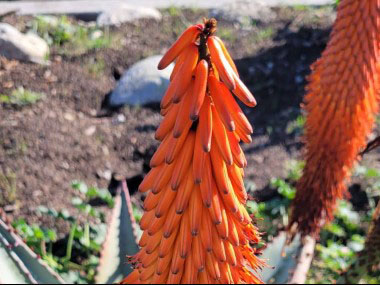
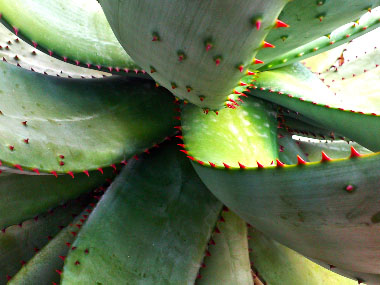
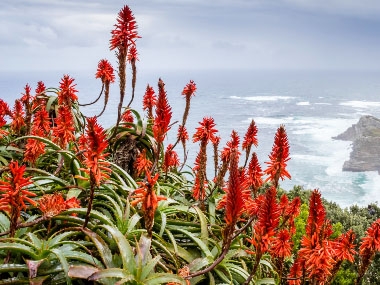
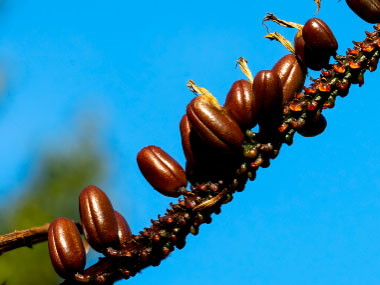
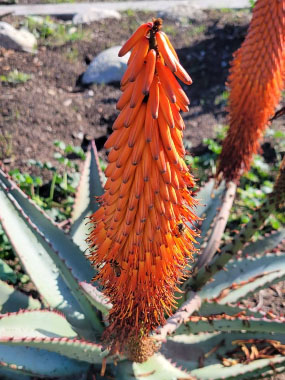
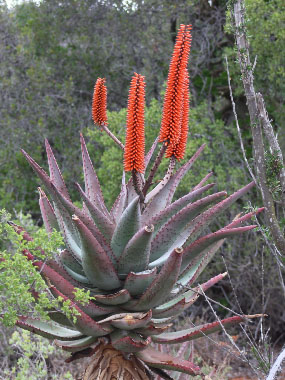
To support our efforts please browse our store (books with health benefits, etc.).
Bitter aloe is in the Asphodelaceae family of plants. Some websites refer to this as a shrub or tree as it has some of those attributes. Those that do grow like a shrub or tree have one thick, unbranched trunk. Common names include Cape Aloe, Red Aloe, Tap Aloe, Bergaalwyn (Afrikaans), and iNhlaba (Zulu). Aloe ferox is among the tallest of all the aloes. The dead and dried leaves that remain on the stem is called the petticoat. Bitter aloe is wind and drought tolerant. Ferox means fierce or war-like, referring to the spiny edged leaves. Interestingly Aloe ferox, along with Aloe broomii, is depicted on a rock painting dated over 250 years ago.
Distinguishing Features
Aloe ferox is single stemmed, grows to an average height of 2 metres (6'), and forms rosettes of large, fleshy leaves. The leaves are thick and dull green in color with reddish spines along the margins of each leaf. If pollinated, bitter aloe produces barrel-shaped seed pods about 1.6 to 2.2cm long (5/8 to 7/8" long).
Flowers
Bitter aloe's inflorescence has the appearance of a candelabra. It can extend 60 cm to 1.3 metres (2 to 4') above the rosette with multiple branches and dense clusters of 2.5 cm (1") long tubular orange flowers. The flowers have a slight widening at the middle. Rather than extending outward at right angles to the floral branch, the flowers are angled slightly downward. Depending on location, there may be some variations in the flower color including yellow, but they are generally orange to reddish-orange. In the northern hemisphere, this is mainly a winter-flowering species. Plants in warmer climate zones tend to flower earlier, while those in the coldest parts of its growing range may not flower until spring. In the southern hemisphere, flowers appear from May to August in warmer areas, later in cooler regions.
 Fields
of Nutrition has medicinal benefits and vitamin/mineral content of Bitter Aloe.
Fields
of Nutrition has medicinal benefits and vitamin/mineral content of Bitter Aloe.
Leaves
Succulent leaves grow in a dense rosette formation. Each plant is composed of up to 60 thick, juicy leaves. They are typically dull green, sometimes with a slightly blue tinge. They may also have a reddish tinge. Spines grow along the leaf margin and are reddish. Small spines may be present on upper and lower surfaces of the leaves as well. Young plants tend to be very spiny. Old leaves remain after they have dried, forming a petticoat on the stem. Leaves grow anywhere from 30 cm to 1 metre (1 to 2') long.
Height
Bitter aloe can reach anywhere from 1 to 4 metres (3 to 12') tall. The variation in height is due to conditions and location.
Habitat
This plant occurs in a broad range of habitats due to a wide distribution range. It is common on rocky hill slopes, often in very large numbers. They grow in xeric shrublands, coastal scrubs, grassland, and in open and bushy areas. Bitter aloe can be grown indoors as a houseplant or outdoors in warmer climates. It does best in well-drained, sandy loam soils in full sun. Native to South Africa, this also grows in some areas around the Mediterranean, California, and in other areas of the southern U.S.
Edible Parts
For hundreds of years, bitter aloe was harvested for its sap. Historically, the sap was obtained by removing leaves and allowing them to drain into a container. The sap was then heated to reduce and concentrate it into a solid mass. Drained leaves, once crushed, renders a clear gel similar to that of aloe vera; which is then used in drinks and cosmetics. More recently, people have used its gel to make jams. Dried leaves are crushed, then used to make an herbal tea. The leaves contain twenty amino acids, choline, chromium, copper, iron, potassium, sodium, and zinc. They also contain vitamins A, B1, B2, B3, B6, B12, C, and E. Flower nectar can be enjoyed as well. Bitter aloe contains almost double the amount of amino acids compared to aloe vera.
Other Name
Cape Aloe.
Similar Plants
Aloe Vera, Agave.
Winter Survival Food Handbook

PDF Plant Magazines
Types of Wild Food
Geographic Zones Seasons
Disclaimer
EdibleWildFood.com is informational in nature. While we strive to be 100% accurate, it is solely up to the reader to ensure proper plant identification. Some wild plants are poisonous or can have serious adverse health effects.
We are not health professionals, medical doctors, nor are we nutritionists. It is up to the reader to verify nutritional information and health benefits with qualified professionals for all edible plants listed in this web site. Please click here for more information.
Why Edible Wild Food?
- Food costs are rising
- Free, wild food is readily abundant
- Wild food adds nutrition to your diet
- Wild food can help treat various medical conditions





